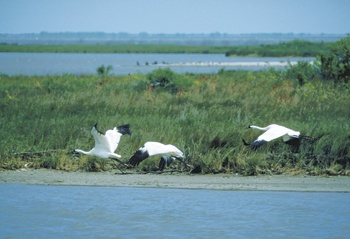When it comes to the precarious existence of Whooping Cranes —an endangered species that numbered just 15 in 1941—the birth of each chick is a cause for celebration. So it wasn’t surprising when Tom Stehn, Whooping Crane coordinator for the U.S. Fish and Wildlife Service, greeted the news of the arrival of twins with the excitement of a new father. On a brisk November morning in 2008, the twins—two of a record 16 Whooping Cranes that descended on the grounds that morning—landed on private property on the Lamar Peninsula north of Rockport on the Texas Gulf Coast. For the chicks and their parents, it marked the end of a 2,500-mile journey from their summer home in Canada’s Wood Buffalo National Park.
Stehn quickly identified the twins’ parents as “Al” and “Diane”—a pair named by wildlife biologists after Al and Diane Johnson, owners of Johnson Ranch, which features the Crane House bed-and-breakfast. Earlier this decade, the Johnsons sold 245 acres of ranch land to the Nature Conservancy, which then donated the land to the Aransas National Wildlife Refuge, where the cranes winter. “This has been the most productive pair during the past dozen years,” Stehn said appreciatively. “They have brought a total of 12 chicks to Aransas in the last 12 years.”
Indeed, biologists prize fertility among the world’s last natural wild flock of Whooping Cranes. North America’s tallest flying birds—nearly 5 feet tall with a 7-foot wingspan—have made a slow climb back from the brink of extinction. Still numbering just 56 birds in 1970, the flock passed the 100-bird mark in 1986, the 200-bird mark in 2004 and now numbers 247. The total number of Whooping Cranes, including captive populations such as one housed at the San Antonio Zoo, stands at 537. Also included in that count are two flocks—one is nonmigratory, and the other migrates between Wisconsin and Florida—of captive birds released into the wild. Neither flock is self-sustaining.
The population rise comes courtesy of 70 years of conservation efforts in the United States and Canada. Habitat protection, wetland restoration and hunter education have all helped the species, once thought to number by the thousands in North America, recover. (Inexperienced hunters sometimes mistake Whooping Cranes—large white birds with distinctive black wingtips visible in flight—for Sandhill Cranes or Snow Geese, which are legal to hunt in most states.)
Although the trend has been generally positive, Stehn is not ready to pass out cigars and declare the cranes’ comeback a complete victory. During the winter of 2008-09, a severe drought in Texas caused the record deaths of seven adults and 16 chicks. With the lack of rainfall and increased water use inland, not enough fresh water flowed into the bays, creating a scarcity of blue crabs, the Whooping Crane’s dietary staple. The birds abandoned their usual salt-marsh habitat to seek fresh water inland and to find food in open bays and upland prairies. During one aerial survey, Stehn spotted a record 21 cranes at game feeders on the Lamar Peninsula. The cranes finally had a bit of luck at the end of March, when a harvest of fiddler crabs gave them a last-minute energy boost before their long journey north.
In coming years, Whooping Cranes will still face many threats. In the air, collisions with power lines, and efforts to avoid cell phone towers and wind turbines, make migration precarious. On the ground, the tar pits associated with vast oil-extraction operations in Alberta, Canada, pose a danger. And on the Texas coast, new housing developments in Seadrift, Holiday Beach, Lamar and Port O’Connor are gobbling up territory that whoopers have occupied in past seasons. Wildlife biologists fear that a single catastrophic event such as an oil spill on the Gulf Intracoastal Waterway could wipe out the entire flock.
But the cranes carry on as they always have, oblivious to human help and hindrance. Come spring, they’ll return to Canada and perform one of nature’s most elaborate mating rituals in which they flap their huge wings and leap into the air. They bow Japanese-style and toss sticks and bits of grass. Then they begin “unison calling.” The female tosses her head back and emits two of the loud whoops for which the birds are named, and the male responds with a single, lower-pitched call. Four months after the chicks are born, they’ll be ready to make their first long-distance migration to Texas—taking off on a wing and a prayer.
——————–
Elaine Robbins has a special interest in wildlife issues.


